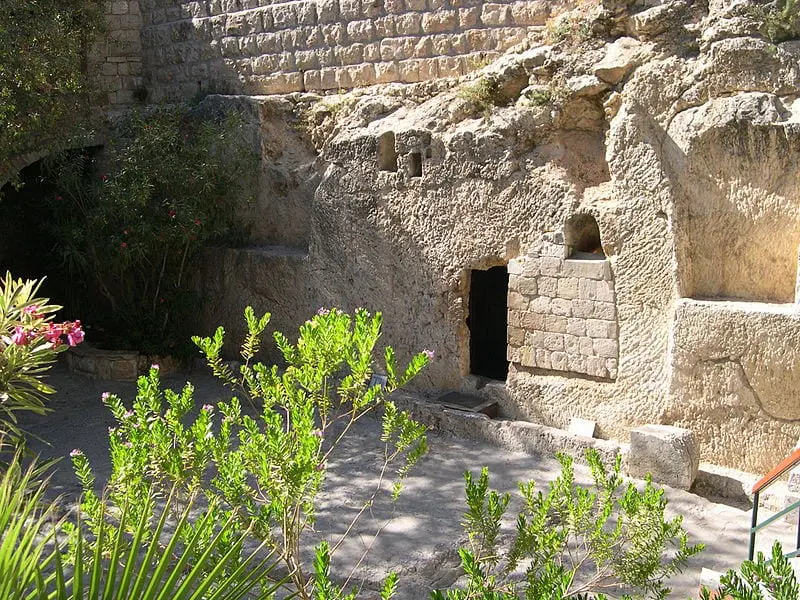During this time of year the thoughts of many people who normally think little about God or Christianity will turn towards church and even spirituality as they put on bright new outfits and head to church for the first time since Christmas. Whether or not you choose to celebrate Easter, the holiday provides a perfect touch point with the culture for introducing a conversation about the Resurrection of Christ and what that means for us today. This Easter Monday as you return to work and regular life after the long weekend, take a moment and ask others “What did you do for Easter?” then follow up with something like, “What do you think about the Resurrection of Jesus, the reason we celebrate Easter?” This provides a perfect opportunity to intently listen to their answer and then correct some of their misunderstandings about Christ’s death and Resurrection and then present the true gospel message.
Inevitably, in discussions about the Resurrection you will be met with skepticism at the idea that a man could rise from the dead. But, as the biblical writer Luke says, there are many “convincing proofs” (Acts 1:3) of the Resurrection of Christ.
First, it must be understood that Christ’s death by crucifixion was not merely a Christian myth or something that was fabricated by the church. Christ’s death, in the manner described in Scripture, is a historical fact. Several non-biblical writers attest to the reality of Jesus death. Josephus, a well-known Jewish historian, recorded that Pilate condemned Christ to death. Tacitus, a Roman historian, wrote that “Christus,” the one who gave Christians their name, was killed by Pilate. The Greek satirist Lucian of Samosata wrote that Christians worship someone who was crucified and a prisoner around that time wrote to his son that the Jewish King was killed. The Jewish Talmud likewise writes that Jesus died at Passover. These non-biblical—and non-Christian—writers all confirm aspects of the biblical account. Jesus did indeed die by crucifixion.
But providing solid evidence of Christ’s death is not enough. As the apostle Paul says, “If Christ has not been raised from the dead, our preaching is useless and so is your faith!” (1 Corinthians 15:14). It is upon the historical reality of the Resurrection that Christianity stands or falls. Happily, God has left a bevy of evidences that confirm the Resurrection of Christ.
Firstly, there is the witness of the disciples. Scripture records the apostles as scattering at Jesus’ arrest (John 26:56) and hiding behind locked doors after his death (John 20:19). Clearly, despite Jesus’ repeated prophecies about his Resurrection, the disciples did not believe that Christ would rise victorious. They were afraid for their very lives. Indeed, one of Jesus’ three closest disciples even denied him three times for fear of suffering a similar fate (Mark 14:66-72). However, after meeting with the Resurrection Lord the disciples became completely different men. The scared, cowardly bunch turned into powerful witnesses for the Lord. They were willing to suffer intense persecution in order to share the gospel. Indeed, not long after Christ’s Resurrection and ascension, Peter, the very man who had earlier denied Christ to ensure the survival of his own skin, boldly declared, along with John, to the religious leaders, “Judge for yourselves, whether it is right in God’s sight to obey you rather than God. For we cannot help speaking about what we have seen and heard” (Acts 4:19-20). They truly believed that they had seen and heard the risen Lord and refused to be quiet about it. According to tradition, all of the apostles (except John, although he suffered persecution and exile) suffered death because of their refusal to stop talking about what they had seen and heard. The witness of the disciples is dramatic evidence that they truly had been with the risen Lord. After all, who would suffer intense persecution and even horrendous martyrdom for something they knew was a lie? No one! There is only one explanation for the change in the disciples; they had been with the Lord.
Jesus’ brothers and sisters are never shown to be enthusiastic supporters of his ministry in Scripture. Indeed, according to the Gospels, Jesus’ siblings were skeptics of his ministry (Mark 3:21, 31, 6:3-4, John 7:5). But, according to 1 Corinthians 15:3-7, which many scholars believe is ancient creedal material that pre-dates the writing of 1 Corinthians, Jesus appeared to his half-brother James. After this event, James becomes a believer and is described as a leader of the church in Jerusalem (Acts 15:12-21, Galatians 1:19). Many scholars even believe that he is the author of the New Testament book of James. Eventually, James suffered death for his refusal to be quiet about the truth of his brother’s Resurrection. His death as a martyr is attested in secular sources such as Josephus, Hegesippus, and Clement. Something happened that completely changed James from a skeptic to a believer in Christ. That something was an encounter with the risen Lord.
Upon his death, Jesus was laid in a tomb to be buried. Resurrection morning, however, the tomb was empty. This is attested by the fact that Jesus was buried in a prominent place. Being near Jerusalem, if someone wanted to discredit the apostles’ story about the Resurrection, they could just go to the tomb and produce Jesus body. Yet no one ever did and we have no records of anyone even trying to do this. But what better way could there have been of shutting the mouths of the disciples but by producing the body of Jesus? Rather than trying to produce his body, Christ’s enemies had to fabricate and story and spread it around to try and make is appear as if Jesus had not risen from the dead. To explain the glaringly empty tomb, the religious leaders spread the story that the disciples stole the body (Matthew 20:12-13, also attested by Justin Martyr and Tertullian). By claiming that the disciples stole the body, the religious leaders were basically admitting that the tomb was empty and there was no body to show the world.
Additionally, it was women, not men, who were the first witnesses to the Resurrection (Matthew 24:9-11). In Jesus’ day the testimony of a woman was largely ignored. Their testimony was not deemed credible. Yet Scripture records women as the first witnesses to the Resurrection—witnesses that “seemed to [the disciples] like nonsense”! (Matthew 24:11) If someone was going to fabricate a story about a resurrection, they would not have used women as the first and primary witnesses to the event. And, yet, it was women who were the first to attest to Christ’s Resurrection. This would have been an embarrassment and would not have been recorded if it were not indeed true. Therefore, on the basis of the principle of embarrassment, this is strong evidence that the account of Christ’s Resurrection from the grave was not a lie devised by the disciples but, rather, was a historical event in real space and time.
To quote the words of the apostle Paul, “but Christ has indeed been raised from the dead!” (1 Corinthians 15:20). The tomb was empty that Resurrection morning because “He is not here! He has risen!” (Luke 24:6) We can have confidence that Christ rose from the dead and, because of his Resurrection, can offer eternal life to all who will repent of their sin and trust in him. If you have not yet trusted in the precious gift that Christ offers, I urge you to “Confess with your mouth Jesus as Lord, and believe in your heart God raised him from the dead, and you will be saved” (Romans 10:9) What is stopping you from receiving the greatest gift ever given to mankind?; “eternal life through Jesus Christ our Lord” (Romans 6:23).
Thank you to Gary Habermas and Michael R. Licona’s The Case for the Resurrection of Jesus.






